Get Chickens | Supplies | Chicken Coops | Security | Feeding | Healthy | Egg Laying
How to Get Chickens for Your Urban Backyard
Chickens can be a lot of fun to raise. They are friendly and inquisitive and can make great pets. With respect to keeping chickens, you should check with local laws about how many can be kept. Many municipalities limit the number of chickens that can be kept. Some don’t allow any at all. Also, male chickens are not usually allowed in the city because of their crowing. Determining the sex of chickens as babies is not very exact. Since if you get chickens as chicks from mail order or farm supply outlets you may end up with male chickens, adoption is a better option. You can adopt them as adult birds. Adult hens can be adopted through your local humane society or animal control. If your local shelter does not have hens available, you can try to adopt a retired hen from a sanctuary.
These hens can usually still lay multiple eggs per week. You also can look at the flyers posted in local farm/feed stores for chickens. Adopting chickens for eggs is a good way to cut down on the number of animals kept in crowded cages at commercial egg farms.
Minimum Supplies Needed to Keep Chickens
Chickens don’t need so many supplies to keep them healthy. They are easy to keep and many starting farmers begin with chickens. Supplies can either be found online or at local feed stores. It is best to use hanging waterers and feeders because the chickens won’t roost on them and they are easy to keep clean. You will need four feeders per one hundred birds. Feed stores sell chicken feed for every stage of the bird’s life. Not only is regular feed necessary for their diet, but also something called scratch. Scratch is made from a combination of grains. This food is basically used as a treat for the chickens. You can also buy plain cracked corn for a treat. Chickens love it.
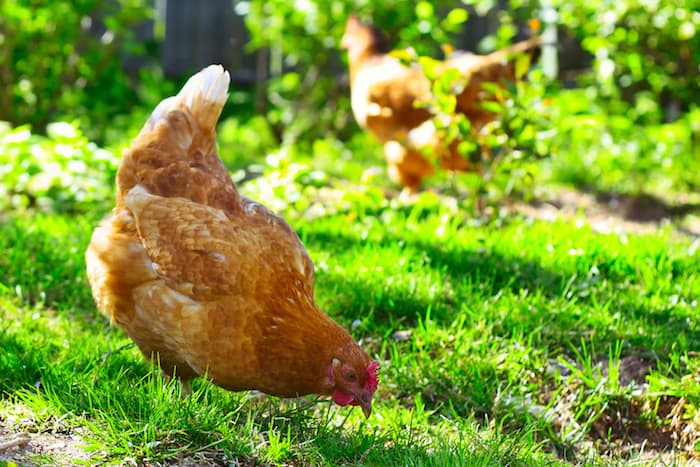
Grit is composed of small stones that chickens need to digest their food. They store it in their crop, and it helps them break down the food. Some feed has grit added to it already.
You also need something that the chickens can sleep on. Pine shavings, straw, and hay are all good choices for bedding. Some people think that straw and hay are not good choices, because they encourage insects and lice to breed in them.
Advice for Building a Chicken House
The first thing to consider when building a chicken coop is that it be safe from predators. This is why a dirt floor is not preferable for your coop. Predators can easily dig under the coop and get in. Wood floors are better. Cover up the holes that expose the coop. They allow rodents and snakes to get inside. Walls should be solid so that predators cannot easily break them down. Also, a decent roof should be put on the coop to keep out predator birds and keep the coop warm. If chickens are not given their space, then they will tend to fight with each other. Try to give four square feet per chicken. The more space that they have, the better off they will be. They need exposure to the air and sun. This is why you will need to give them a little bit of yard space. Make sure that you have a proper fence around the yard so that daytime predators cannot access them. They need a special place to roost or sleep. You should give them a rod that allows all the chickens sleeping space. You should not make the nesting boxes right below this space, because they will defecate all over the nesting boxes. They need a private place to lay their eggs. You should build in a separate place in the coop an adequate place for them to make their nests.
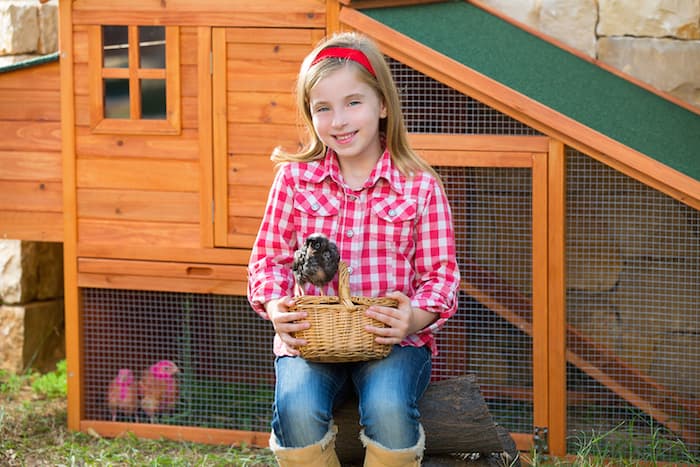
Tips on Making Your Backyard Chicken Coop and Range Safe and Secure
- To ensure your chickens’ safety, you should not allow them to roost outside. Make sure your coop has a lockable door and train the chickens to return to the coop at night.
- Chicken wire is good for keeping chickens in but not very good for keeping predators out. You should make your chicken range impregnable to predators by using solid walls around it.
- Plug up any holes in the coop with hardware cloth that will not allow snakes and rodents inside.
- You should use two-step locks on the doors of the coop. Many species of animals are clever enough to open simple locks on doors.
- Food should never be left outside of the coop when the chickens are not eating. Food attracts mice and other rodents and this can stress out the chickens.
- There are various animals that can be posted outside of the chicken coop for their safety. Certain breeds of dogs are excellent livestock guardians. Two breeds, in particular, are the Great Pyrenees and the Akbash.
- Finally, provide places for the chickens to hide. Some bushes or small trees are a good place for them to hide in case a predator stops by.
What Do You Feed Chickens?
Feeding your chickens a well-balanced diet is essential to their health, growth, and ability to produce eggs. High-quality chicken pellets can be purchased to be the mainstay of their diet. As mentioned before, it is wise to have a feeder to keep the feed dry and clean. In addition to the main feed that the chickens receive, it is good to give them fresh fruits and vegetables for nutrients. Examples of appropriate vegetables are cabbage and bok choy.To augment their diet, you should throw some grains such as wheat and corn around their range.
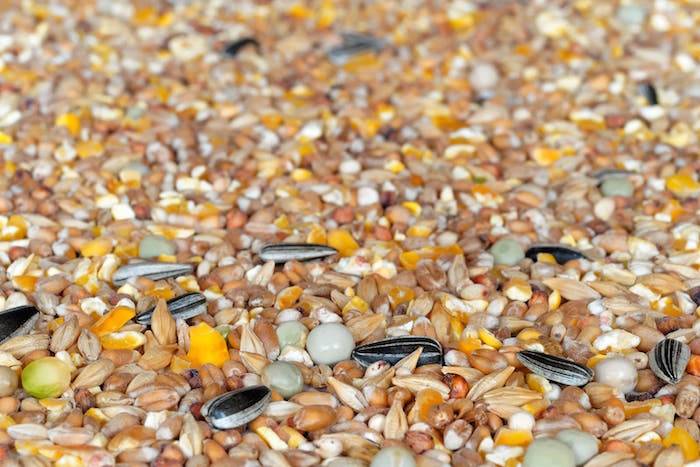
Table foods such as rice and cooked pasta can be a special treat for the chickens. You should check with your vet about any foods from your table that you have questions about. Food scraps that are high in fat or salt should be avoided, as well as anything that is spoiled or rancid. As mentioned before, chickens need access to grit for digestion. You should also give them access to earthworms and insects in leaf litter and compost. Chickens can eat some plants that grow outside but beware of any poisonous plants that could be a danger. Clean water must always be given to the chickens. Be careful in the wintertime that the water doesn’t freeze over.
Okay to Feed Chickens
- Strawberries, Blueberries, Raspberries
- Watermelon & Cantaloupe (seeds and rinds okay)
- Pumpkin & squash
- Kale, Spinach, Clover, Mustard Greens
- Broccoli & Cauliflower
- Cherries, Grapes, Apples, tomatoes (no seeds)
- Bananas
- Chickweed, Crabgrass, Dandelions and Thistles
- Eggs (scrambled hard boiled)
- Meal and Earthworms (freeze-dried or fresh)
- Crickets and other insects (freeze-dried or fresh)
- Fish and Shellfish (fresh only)
Treats
- Stale Bread (Sparingly)
- Cooked Oatmeal
- Flaxseed
- Plain Yogurt
- Cooked Pasta
- Cooked Rice
- Unsalted Sunflower Seeds
Do Not Feed
- Avocado Skins or Pits (toxic)
- Citrus Fruits (too acidic)
- Long Grasses (avoid impaction)
- Dried Beans (toxic)
- Garlic in Large Doses (toxic)
- Raw Green Potato or Skins (toxic)
- Any Moldy Food (toxic)
- Chocolate or Candy (toxic)
Harmful foods and acceptable diet options according to hobbyfarms.com
Keeping Your Chickens Happy and Healthy
Here are a few tips for keeping your chickens happy and healthy:
- Make sure that their coop is well ventilated. Although this is not a license to leave holes for predators, all creatures great and small need fresh air.
- Chickens need space to roam around in. While in an urban environment it might not be so easy to find adequate roaming space, you should at least give them a small amount of space as a range.
- Make sure to vary their diet. Like all animals, chickens can get bored of their diet. While their staple feed does not have to change, the fruits and vegetables and table scraps that you give them can be changed every once in a while.
Treating Health Issues
For specific illnesses, their signs & symptoms, treatment, and prevention options view the illness directory
List of Chicken Health Problems
Build a First Aid Kit for Treating Chickens
It is wise to keep a well-stocked first aid kit for the many circumstances for which you can easily intervene to care for your flock.
- Latex or Vinyl Gloves – to protect both you and the birds
- Face Protection – eye-wear and mask help prevent the transmission of airborne pathogens
- Rubbing Alcohol – for cleaning and disinfecting
- Hydrogen Peroxide – useful as an initial wound cleaner when diluted with water
- Chlorhexidrine Solution – less caustic than Hydrogen Peroxide
- Neosporin – a triple antibiotic ointment that also promotes healing
- Gauze – rolls, non-stick pads, and tapes to dress wounds
- Scissors
- Styptic – flour or blood-stop powder to help stop bleeding
- Hemorrhoid Cream and Lubricating Jelly – useful in treating prolapsed tissue
- Vitamins and Electrolytes – boost a bird’s energy in extremely hot weather or in circumstances of shock from attack, available at feed stores as Sav-A-Chick.
- Apple Cider Vinegar – curtails slime building up in waterers, as long as they are not galvanized dispensers, which easily corrodes from the acidic nature
- Syringes – from feeding to administering medications
- Cotton swabs – multiple uses including applicators and wound cleaners
- Pet nail trimmer/file – for trimming and filing beaks
- Surgical kit – Surgical blades, needle, and thread or Super Glue, tweezers
Preventing Illness in Your Chickens
At the outset, proper hygiene, good housekeeping, and a clean, comfortable environment without overcrowding are the simplest measures you can take to keep your flock healthy. The majority of exposure comes through poor conditions and exposure to other birds. Keep the coop well-ventilated, warm, and dry without overheating with plenty of “wing room” and your birds will thrive. In many ways, chickens appreciate the same conditions as humans. Be mindful of the risk of sharing equipment or visiting other bird environments. You could be the source of transferring diseases or parasites or contaminating your own flock when exposed to locations that are not as well-kept as your own.
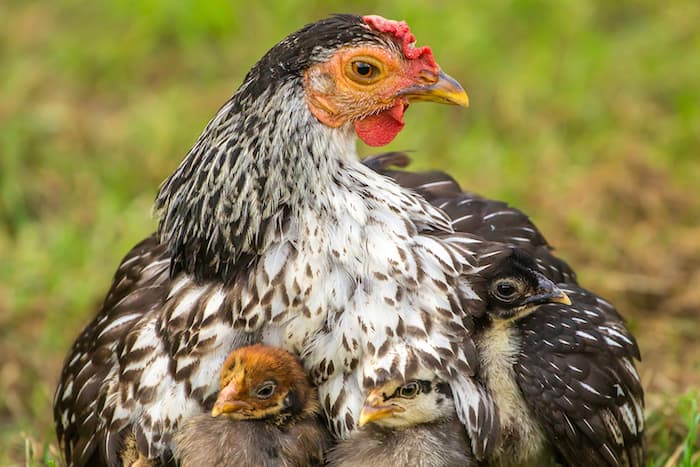
Knowing When to Call the Vet
Observing your chickens on a daily basis is the best way to gauge what is normal. Your best preventive care and good husbandry will keep your chickens in robust health. This does not mean, however, there will never be a need to consult the vet.
- Weight loss
- Distended crop
- The appearance of parasites
- Leg scales that are rough and thickened
- Loss of appetite
- Sneezing
- Difficulty breathing
Should you lose a chicken to illness, you have an excellent opportunity to discover the cause of death through necropsy. It is a sure method of detecting viruses or bacteria that may be affecting your flock. The California Animal Health and Food Safety (CAHFS) laboratories provide this service for free for the first two birds. You can contact them to learn the proper steps to take advantage of this vital service.
Egg Laying and Collection Basics
Besides giving your chickens a proper diet and a proper coop, there are a few things you can do to help your chicken lay their eggs. First of all, keep their coop clean. Chickens should have enough personal space in the coop and its cleanliness ensures healthy chickens.

Make sure that they have covered nest boxes that are kept regularly clean. Light is necessary for chickens to lay their eggs. Experts say that they need fourteen hours of light every day to lay eggs. Artificial lights on timers can be used during the wintertime when there are fewer daylight hours. With respect to egg collection, eggs should be gathered as early as possible after they are laid to inhibit them from getting dirty.
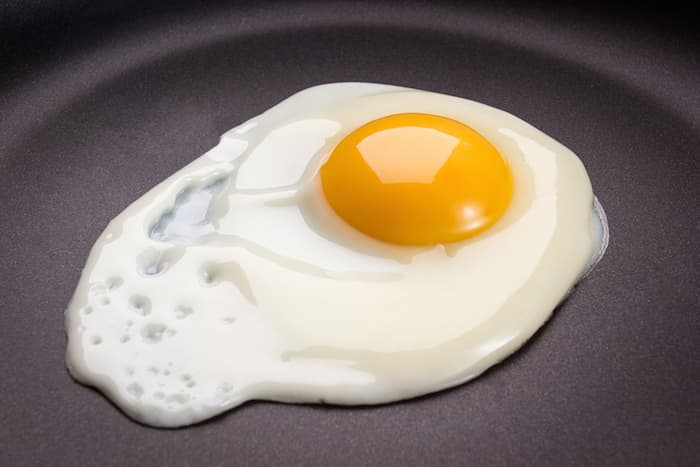
Collecting them twice a day prevents them from getting dirty or from the chickens eating the eggs. You should make sure that you clean the eggs properly so that no one in your family gets sick from them. With proper care, a chicken or chickens can make a wonderful pet. They are also a source of fresh eggs for you and your family.
Further Reading
Should You Own a Chicken
Winterizing a Chicken Coop
Chickens in Action
Reviewed By: Tim Winter


Tim Winter has a strong affection for pets and wildlife. His years of experience caring for various types of pets has led him to share his knowledge with others on the best practices in pet care. Tim holds a Bachelor of Science from the University of Oregon School of Journalism and Communications.
